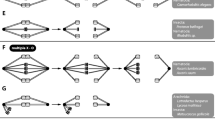Summary
1. The chromosome number differs in the two sexes; in the male it is 64, in the female 63.
2. This numerical difference is due to theZ-chromosomes; in the male they make a homologous pair, while in the female the sex-chromosome remains unpaired.
3. Heterogamety therefore exists in the female sex, just as in the Squamata and the Aves.
4. TheZ-chromosome is very likely the 16th one shown in the alignmental arrangement of the univalent chromosomes.
5. Of the 31 pairs of autosomes, only the three largest pairs are atelomitic, and of these Nos. 1 and 3 have arms of different lengths. In particular chromosome No. 3 has the shape ofJ since one of its arms is remarkably short.
6. The phenomenon of precocious maturation was noticed up to the stage of the onset of the first division, but the spindle did not take up the characteristic peripheral position so as to be regarded as the polar spindle. In such cells, theZ-chromosome was sharply defined from the ordinary tetrads by its univalent nature, but its behaviour in the first maturation division remains to be followed.
Similar content being viewed by others
References
Allen, B. M. (1915). “The embryonic development of the rete-cords and sex cords ofChrysemys.”Amer. J. Anat. 5.
-- (1916). “The origin of sex cells ofChrysemys.”Anat. Anz. 29.
Andres, A. H. &Vögel, I. I. (1936). “Karyologische Studien der Menschenovogenese. I.”Z. Zellforsch. 24.
Firket, J. (1914). “Recherches sur l’organogenèse de glandes sexuelles chez les oiseaux.”Arch. Biol. 29.
Jordan, H. E. (1914). “Spermatogenesis inCrysemys marginata andCistudo carolina.”Science, N.S.39.
Keenan, R. D. (1932). “The chromosomes ofSphenodon punctatum.”Amer. J. Anat. 67.
Kingery, H. M. (1914). “So-called parthenogenesis in the white mouse.”Biol. Bull. Wood’s Hole,27.
Matthey, R. (1929). “Chromosomes de Sauriens: Gekkonidae, Agamidae, Iguanidae, Zonuridae, Anguidae, Lacertidae, Scincidae, Chameleonidae.”C.R. Soc. Phys. Hist. nat. Genève,46.
-- (1930). “Chromosomes de Reptiles.”C.R. Soc. Biol., Paris,103.
-- (1931a). “Chromosomes de Reptiles sauriens, Ophidiens, Chéloniens. L’évolution de la formule chromosomiale chez les Sauriens.”Rev. Suisse Zool. 38.
-- (1931b). “Chromosomes de Sauriens: Helodermatidae, Varanidae, Xantusiidae, Annelidae, Anguidae.”Ibid. 57.
-- (1931c). “Les chromosomes des Amphisbéniens acrodontes (Trogonophis wiegmanni Kaup).”Bull. Soc. vaud. Sci. nat. 57.
-- (1932a). “Les chromosomes de l’Amphisbénien acrodonte:Trogonophis wiegmanni Kaup.”Arch. Zool. exp. gén. 74.
-- (1932b). “Chromosomes de Sauriens (Tejidae).”C.R. Soc. Biol., Paris,110.
-- (1932c). “Nouvelle contribution à l’étude des chromosomes chez les Sauriens.”Bull. Soc. vaud. Sci. nat. 57.
-- (1932d). “Les chromosomes et la systematique zoologique.”Rev. Suisse Zool. 39.
-- (1933a). “La formule chromosomiale deTupinambis teguixin L. et d’Ameiva surinamensis Laur.”C.R. Soc. Biol., Paris,113.
Matthey, R. (1933b). “Nouvelle contribution à l’étude des chromosomes chez les Sauriens.”Rev. Suisse Zool. 40.
-- (1934). “La formule chromosomiale duLacerla vivipara Jacquin.”C.R. Soc. Biol., Paris,117.
Nakamura, K. (1927). “Preliminary notes on reptilian chromosomes. I. The chromosomes of some snakes.”Proc. Imp. Acad. Tokyo,3.
-- (1928a). “Studies on reptilian chromosomes. I. On the chromosomes of a snake.”Mem. Coll. Sci. Kyoto, B,4.
-- (1928b). “Preliminary notes on reptilian chromosomes. II. The chromosomes of a lizard,Tachydromus tachydromoides.”Ibid. 4.
-- (1931a). “Preliminary notes on reptilian chromosomes. III. The chromosomes of some lizards.”Ibid. 7.
-- (1931b). “Studies on reptilian chromosomes. II. On the chromosomes ofEumeces latiscutatus (Hallowell), a lizard.”Cytologia,2.
-- (1932). “Studies on reptilian chromosomes. III. Chromosomes of some geckos.”Ibid. 3.
-- (1935a). “Studies on reptilian chromosomes. IV. Chromosomes ofTachydromus spp. (lizard).”Mem. Coll. Sci. Kyoto, B,10.
-- (1935b). “Studies on reptilian chromosomes. V. Chromosomes ofJaparula swinhonis (a lizard).”Ibid. 10.
-- (1935c). “Studies on reptilian chromosomes. VI. Chromosomes of some snakes.”Ibid. 10.
-- (1935d). “Studies on reptilian chromosomes. VII. Chromosomes of a turtle,Clemmys japonica (Temm. & Schl.).”Ibid. 10.
Oguma, K. (1934). “Studies on the sauropsid chromosomes. II. The cytological evidence proving female heterogamety in the lizard (Lacerta vivipara).”Arch. Biol. 45, 27–46.
Risley, P. L. (1933a). “Contributions on the development of the reproductive system inSternotherus odoratus (Latreille). I. The embryonic origin and migration of the primordial germ cells.”Z. Zellforsch. 18.
-- (1933b). “Contributions on the development of the reproductive system in the musk turtle,Sternotherus odoratus (Latreille). II. Gonadogenesis and sex differentiation.”Ibid. 18.
-- (1936). “The chromosomes of the male musk turtle,Sternotherus odoratus (L.).”Cytologia,7.
Rubaschkin, W. (1912). “Zur Lehre von der Keimbahn bei Säugetieren.”Anat. Hefte,46.
Stejneger, L. (1907). “Herpetology of Japan and adjacent territory.”Spec. Bull. U.S. nat. Mus. No. 58.
Swingle, W. W. (1921). “The germ cells of anurans. I. The male sexual cycle ofRana catasbeiana larvae.”J. exp. Zool. 32.
Winiwarter, H. &Sainmont, G. (1908–09). “Nouvelles recherches sur l’ovogenèse et l’organogenèse de l’ovarie des mammifères (Chat).”Arch. Biol. 24.
Author information
Authors and Affiliations
Additional information
Part I of this series was published in theJ. Coll. Agric. Sapporo,16 (1928), and Part II inArch. Biol. 45 (1934).
Contribution No. 108 from the Zoological Institute, Faculty of Science, Hokkaido Imp. Univ., Sapporo.
Rights and permissions
About this article
Cite this article
Oguma, K. Studies on sauropsid chromosomes. Journ. of Genetics 34, 247–264 (1937). https://doi.org/10.1007/BF02982266
Issue Date:
DOI: https://doi.org/10.1007/BF02982266




